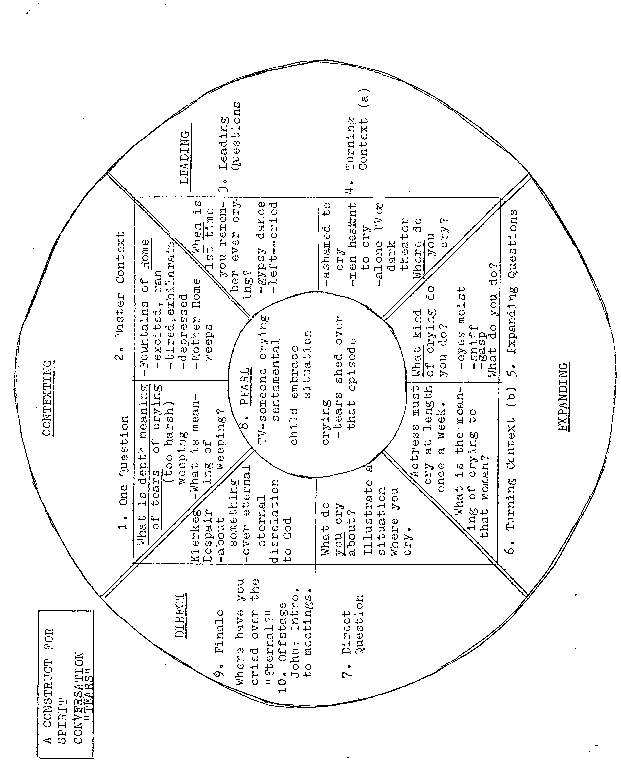
| The Explanations | The Questions and Comments |
| Raise just one question. It must push toward the ontological meaning. Has to be put at the first of the conversation, Yet you have to be careful that it isn't abstract. Don't give them a chance to answer. Go immediately to: | What is the depth meaning of tears? . . . of crying? Crying may be too harsh; maybe weeping is better, What does it mean to weep?
|
| The master context must be ontological instead of moral.
It is crucial that you have eye contact with all participants. | I remember the great fountains of Rome, I was so excited when I first saw them that I almost ran from fountain to fountain, Late that night it was 2:00 am. I was tired, but it had been an exhilarating day; I suddenly found myself getting highly depressed. Upon reflection it seemed that the fountains represented Mother Rome as a woman in travail, weeping over the great events in her life. |
| Ask questions and let response come from the group. Ask or tell illustrations from your own life that will keep the conversation moving. You are after getting out grist for the conversation, | When is the first time you remember ever crying?
I remember when I was a child some gypsies visited us and danced and sang, Finally they left and when they waved goodbye I burst into tears, |
| Within the above you have a turning context. Ask a question that will turn the conversation. You are after the turn flowing rather than moving abruptly | I've always been ashamed to cry. Probably one great difference between men and women is that men are hesitant to cry, I usually only cry when I watch TV alone or in a dark theater, Where do you cry? |
| Now you ask a series of questions that expand their reflection
Let your questions come rapidly. Let only two or three people respond to each. You are not after impressions, but always reflection. | What kind of crying do you do? Do your eyes get moist, or do you sniff? Some people gasp.
What do you do? Where? Others? When? |
| You are the Guru talking although you are getting others to do your talking for you
Again, you are only after a few responses at this point. | I know an actress who said that if she didn't have a gushing and lengthy cry every week she couldn't keep herself together. What was the meaning of crying to that woman? |
| These are to set the context for the pearl
Several questions and responses are usually sufficient | What do you cry about?
Give us a situation where you cry? |
| The pearl must be a crucial insight into the depths of life. It can't be superficial or game playing, but must push to the ontological.
The tone of voice is crucial; quiet, with no pushing. You may or may not allow some talking after the pearl depending on your need to get to the finale. | The other night I was half watching the TV while I was working and someone was crying about something it seemed to be sentimental I began to pay more attention, however, and it was about how a little child embraced a situation and sort of grew up. I found that I had tears in my eyes, and shrugged it off as sentimental, Then I became aware that although I was crying about that episode, I wasn't crying over that, but over something out there that impinges upon me. |
| Finale underscores what you have said in the Pearl. You leave them amazed at what happened to them,
You don't wrap up or close off.. You leave them with their lives on their hands. | Kierkegaard put it that you may despair about something, but at the same time you despair over the Eternal. (Draw a tear drop ), Wherever tears come down your face you are crying over the Eternal over your own disrelation with God. Where have you cried over the Eternal? |
| Change the subject. Abruptly move to something else. Total time may vary from 10 to 20 minutes. | I think John has the introduction to our readings tonight. |
 |